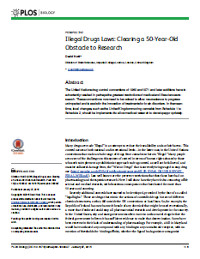Illegal drugs laws: Clearing a 50-year-old obstacle to research
The United Nations drug control conventions of 1960 and 1971 and later additions have inadvertently resulted in perhaps the greatest restrictions of medical and life sciences research. These conventions now need to be revised to allow neuroscience to progress unimpeded and to assist in the innovation of treatments for brain disorders. In the meantime, local changes, such as the United Kingdom moving cannabis from Schedule 1 to Schedule 2, should be implemented to allow medical research to develop appropriately.

Authors
Many drugs are made "illegal" in an attempt to reduce their availability and so their harms. This control occurs at both national and international levels—in the latter case, in the United Nations conventions that make a whole range of drugs from cannabis to heroin "illegal." Many people are aware of the challenges to this system of control in terms of human rights abuses by those who seek to implement a prohibitionist approach to drug control, as well as the failure of, and massive collateral damage from, the "War on Drugs" that is currently being waged to stop drug use. Less well known are the perverse restrictions that these laws have had on pharmacology and therapeutics research. Here I will show how they have led to censoring of life science and medical research, with disastrous consequences that have lasted for more than 50 years and counting.
Recently additional controls have started to be developed, provoked by the fear of so-called "legal highs." These are drugs that mimic the actions of controlled drugs but are of different chemical structures, so they fall outside the UN conventions or local laws. So, for example, the Republic of Ireland has now banned the sale of any chemical that might be used recreationally, a move that if enforced could stop all pharmaceutical research and development in the country. In the United States, city and state governments often move to outlaw novel drugs before the federal government believes it has sufficient evidence to make that determination. Some have been extreme in their lack of understanding of pharmacology. For example, a bill in Maryland would have outlawed any compound with any binding to any cannabinoid receptor, with no mention of thresholds for binding affinity, whether the ligand had agonist or antagonist efficacy, or whether actions at other receptor sites might moderate overall abuse potential. This demonstrates a very extreme version of prohibition, in which molecular entities that have yet to exist are deemed Schedule 1, as if we had absolute ability to perfectly predict the activity of a novel chemical structure.